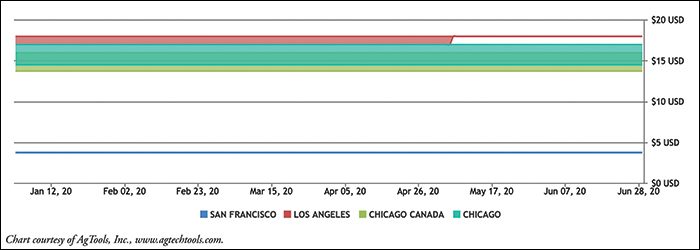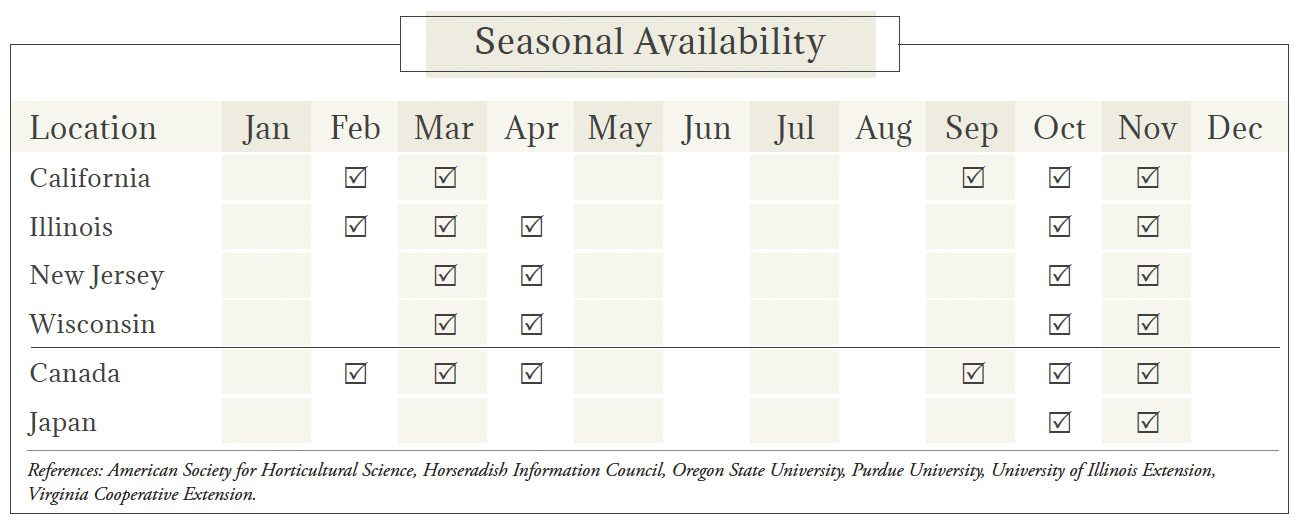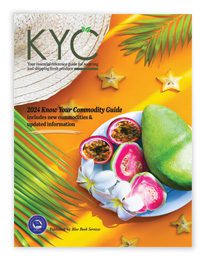Horseradish Root Market Summary


Image: linerpics/Shutterstock.com
Horseradish Root Market Overview
Horseradish, Armoracia rusticana, is a thick root vegetable and part of the Brassicaceae family along with broccoli, cabbage, radishes, mustard, and wasabi (often called Japanese horseradish). It can be grown as an annual or perennial and is commonly used in American and European cuisine as a spice or part of soups, sauces, and spreads. Horseradish is believed to have originated in Europe, where it was lauded for its medicinal properties. A region of the U.S. Mississippi River floodplain, called the ‘American Bottoms’ in southwestern Illinois, is where the vast majority is grown. Other states grow the root in lesser quantities, including California, New Jersey, Oregon, and Wisconsin. Canada also grows horseradish, and it is still cultivated in Europe. The sturdy, tapered root is harvested for culinary use. Top quality roots are white, straight, and free of speckling or discoloration with a diameter close to 2 inches, weighing in at a couple pounds each. Horseradish root is most often ground or shredded, but can be dehydrated to lock in its pungent flavor.
Types & Varieties of Horseradish Root
Varieties are based on the type of root and include Common (also called Maliner Kren), Czech (a newer cultivar), Bohemian (including Sass and Swiss), Big Top Western, Variegata, and Wild Root. When crushed, shaved, shredded, or ground, it releases mustard oil, responsible for its ‘hot’ ?avor and sharp, penetrating odor. Once roots are exposed to air, they will turn brown and lose intensity. Cooking will reduce pungency as well. ‘Prepared horseradish’ is the ground root mixed with vinegar and is particularly popular in the United Kingdom, while various dressings and mayonnaise containing grated horseradish are sought after in the United States. Mixing with mustard is another centuries-old use, originating in Europe. More recently, due to declining availability of wasabi plants, horseradish (a close relative) has become a substitute in sushi dishes.The Cultivation of Horseradish Root
Horseradish is a robust plant, able to regenerate from small pieces of root. Plants thrive in potassium-rich soil, ample sunlight, and can be planted in spring or fall for harvest in late fall and winter (or left to overwinter till early spring). Cultivation can be a lengthy process; it can take more than one season to transition from initial planting to a marketable crop. If leftover root pieces aren’t managed properly once planted, horseradish can become an invasive weed in its own crop.
Pests & Diseases Affecting Horseradish Root
There are a variety of insects that feed on horseradish root, some bringing other complications with them. Aphids spread turnip mosaic virus, hosted by nearby weeds and various plants. Other insects of note are the imported crucifer weevil, caterpillars, horseradish ?ea beetle, two-dotted mites, cabbage worms or loopers, and the beet leafhopper. Pre- and post-emergent herbicide applications are recommended to treat foliar diseases such as white rust, bacterial leaf spot, ramularia leaf spot, and cercospora. Verticillium can cause root discoloration, a?ecting crops if untreated.Storage & Packaging of Horseradish Root
Horseradish roots can be stored, wrapped in plastic, for months at cool temperatures (35 to 40°F) with high relative humidity. Packaging ranges from large shrink-wrapped pallets or burlap bags for commercial processing to small bags for specialty retailers and restaurants. References: American Society of Horticultural Science, Herb Society of America, Horseradish Information Council, University of Arkansas, Virginia Cooperative Extension, USDA.Grades & Good Arrival of Horseradish Root
Horseradish is graded as U.S. Fancy, U.S. No. 1, U.S. No. 2, or ‘unclassi?ed’ by the USDA; U.S. Fancy requires roots be well-trimmed, well-shaped, and fairly smooth, free from decay and damage caused by dirt, sunburn, cuts, cracks, internal discoloration, mold, freezing, insects, or mechanical injury. Roots must have a length of least 8 inches and 1.5 inch or greater diameter; if length exceeds 8 inches, the diameter can be slightly less but not under 1.25 inches. For U.S. No. 1, roots must be ?rm, well-trimmed, fairly well shaped, not excessively rough, and free from decay and damage as mentioned above. Length must be at least 6 inches in length with a diameter of 1.25 inches or more; if longer than 6 inches, diameter may be slightly less but nor under 1 inch. The U.S. No. 2 grade requires roots be ?rm, well-trimmed, and free from decay and serious damage. Roots must be at least 4 inches in length and not less than half an inch in diameter.Generally speaking, the percentage of defects shown on a timely government inspection certificate should not exceed the percentage of allowable defects, provided: (1) transportation conditions were normal; (2) the USDA or CFIA inspection was timely; and (3) the entire lot was inspected.
| U.S. Grade Standards | Days Since Shipment | % of Defects Allowed | Optimum Transit Temp. (°F) |
| 10-5-2 | 5 4 3 2 1 | 15-8-4 14-8-4 13-7-3 12-6-2 10-5-2 | 32° |
Horseradish Terminal Market Pricing: Per 5 lb. Carton




